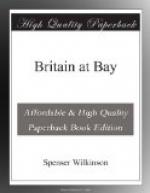His fierce determination to get at the ultimate secrets of his trade led him to use every means that would help him to think out his problem, and among these means was reading. In 1780 appeared Clerk’s “Essay on Naval Tactics.” Clerk pointed out the weakness of the method of fighting in two parallel lines and suggested and discussed a number of plans by which one fleet with the bulk of its force could attack and destroy a portion of the other. This was the problem to which Nelson gave his mind—how to attack a part with the whole. On the 19th of August 1796 he writes to the Duke of Clarence:—
“We are now 22 sail of the line, the combined fleet will be above 35 sail of the line.... I will venture my life Sir John Jervis defeats them; I do not mean by a regular battle but by the skill of our Admiral, and the activity and spirit of our officers and seamen. This country is the most favourable possible for skill with an inferior fleet; for the winds are so variable that some one time in the 24 hours you must be able to attack a part of a large fleet, and the other will be becalmed, or have a contrary wind.”
His opportunity came in 1798, when in the battle of the Nile he crushed the French Mediterranean Fleet. In a letter to Lord Howe, written January 8, 1799, he described his plan in a sentence:—
“By attacking the enemy’s van and centre, the wind blowing directly along their line, I was enabled to throw what force I pleased on a few ships.”
We know that Nelson’s method of fighting had for months before the battle been his constant preoccupation, and that he had lost no opportunity of explaining his ideas to his captains. Here are the words of Captain Berry’s narrative:—
“It had been his practice during the whole of the cruise, whenever the weather and circumstances would permit, to have his captains on board the Vanguard, where he would fully develop to them his own ideas of the different and best modes of attack, and such plans as he proposed to execute upon falling in with the enemy, whatever their position or situation might be, by day or by night. There was no possible position in which they might be found that he did not take into his calculation, and for the most advantageous attack on which he had not digested and arranged the best possible disposition of the force which he commanded.”
The great final victory of Trafalgar was prepared in the same way, and the various memoranda written in the period before the battle have revealed to recent investigation the unwearying care which Nelson devoted to finding out how best to concentrate his force upon that portion of the enemy’s fleet which it would be most difficult for the enemy to support with the remainder.




